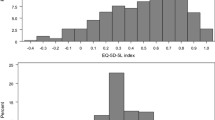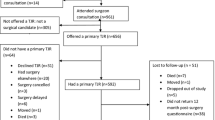Abstract
Purpose
To assess the test–retest reliability of the EQ-5D-5L (5L) and compare the validity of the 5L and EQ-5D-3L (3L) in osteoarthritis patients referred to an orthopaedic surgeon for total joint replacement.
Methods
We mailed questionnaires to 306 consecutive patients following referral and a second questionnaire after 2 weeks to assess reliability. Questionnaires included the 5L, EQ-VAS, Short Form-12, Oxford hip and knee scores, pain VAS, and the 3L. We compared the ceiling effect, redistribution properties, convergent and discriminant validity, and discriminatory power of the 5L and 3L.
Results
We obtained 176 respondents (response rate 58 %), 60 % female, 64 % knee patients, mean age 65 years (SD 11), with no significant differences between responders versus non-responders. Intraclass correlation coefficients were 0.61–0.77 for the 5L dimensions and 0.87 for the 5L index. For the 3L, most patients used level 2 (some/moderate problems) for mobility (87 %), usual activities (78 %), and pain/discomfort (71 %). In comparison, 5L responses were spread out with only 52, 42, and 50 %, respectively, using the middle level. All convergent validity coefficients were stronger with the 5L (Spearman coefficients 0.51–0.75). Absolute informativity (Shannon’s index) showed higher results for all dimensions of the 5L compared with the 3L (average difference 0.74). Relative informativity (Shannon’s evenness index) showed an increase from the 3L to the 5L in mobility, usual activities, and pain/discomfort.
Conclusions
The 5L provided stronger validity evidence than the 3L, especially for dimensions relevant to this patient population—mobility, usual activities, and pain/discomfort.

Similar content being viewed by others
References
Bombardier, C., Melfi, C. A., Paul, J., Green, R., Hawker, G., Wright, J., et al. (1995). Comparison of a generic and a disease-specific measure of pain and physical function after knee replacement surgery. Medical Care, 33(4 Suppl), AS131–AS144.
Guccione, A. A., Felson, D. T., & Anderson, J. J. (1990). Defining arthritis and measuring functional status in elders: Methodological issues in the study of disease and physical disability. American Journal of Public Health, 80(8), 945–949.
Laupacis, A., Bourne, R., Rorabeck, C., Feeny, D., Wong, C., Tugwell, P., et al. (1993). The effect of elective total hip replacement on health-related quality of life. Journal of Bone and Joint Surgery. American Volume, 75(11), 1619–1626.
Hawker, G. A., Stewart, L., French, M. R., Cibere, J., Jordan, J. M., March, L., et al. (2008). Understanding the pain experience in hip and knee osteoarthritis: an OARSI/OMERACT initiative. Osteoarthritis Cartilage, 16(4), 415–422.
Brooks, R. (1996). EuroQol: The current state of play. Health Policy, 37(1), 53–72.
Brazier, J., Roberts, J., Tsuchiya, A., & Busschbach, J. (2004). A comparison of the EQ-5D and SF-6D across seven patient groups. Health Economics, 13(9), 873–884.
Sullivan, P. W., Lawrence, W. F., & Ghushchyan, V. (2005). A national catalog of preference-based scores for chronic conditions in the United States. Medical Care, 43(7), 736–749.
Janssen, M. F., Pickard, A. S., Golicki, D., Gudex, C., Niewada, M., Scalone, L., et al. (2013). Measurement properties of the EQ-5D-5L compared to the EQ-5D-3L across eight patient groups: A multi-country study. Quality of Life Research, 22(7), 1717–1727.
Johnson, J. A., & Pickard, A. S. (2000). Comparison of the EQ-5D and SF-12 health surveys in a general population survey in Alberta, Canada. Medical Care, 38(1), 115–121.
Giesinger, K., Hamilton, D. F., Jost, B., Holzner, B., & Giesinger, J. M. (2014). Comparative responsiveness of outcome measures for total knee arthroplasty. Osteoarthritis Cartilage, 22(2), 184–189.
Conner-Spady, B., & Suarez-Almazor, M. E. (2003). Variation in the estimation of quality-adjusted life-years by different preference-based instruments. Medical Care, 41(7), 791–801.
Ostendorf, M., van Stel, H. F., Buskens, E., Schrijvers, A. J., Marting, L. N., Verbout, A. J., et al. (2004). Patient-reported outcome in total hip replacement. A comparison of five instruments of health status. Journal of Bone and Joint Surgery. British Volume, 86(6), 801–808.
Fransen, M., & Edmonds, J. (1999). Reliability and validity of the EuroQol in patients with osteoarthritis of the knee. Rheumatology (Oxford), 38(9), 807–813.
Wolfe, F., & Hawley, D. J. (1997). Measurement of the quality of life in rheumatic disorders using the EuroQol. British Journal of Rheumatology, 36(7), 786–793.
Herdman, M., Gudex, C., Lloyd, A., Janssen, M., Kind, P., Parkin, D., et al. (2011). Development and preliminary testing of the new five-level version of EQ-5D (EQ-5D-5L). Quality of Life Research, 20(10), 1727–1736.
van Hout, B., Janssen, M. F., Feng, Y. S., Kohlmann, T., Busschbach, J., Golicki, D., et al. (2012). Interim scoring for the EQ-5D-5L: Mapping the EQ-5D-5L to EQ-5D-3L value sets. Value Health, 15(5), 708–715.
Luo, N., Li, M., Chevalier, J., Lloyd, A., & Herdman, M. (2013). A comparison of the scaling properties of the English, Spanish, French, and Chinese EQ-5D descriptive systems. Quality of Life Research, 22(8), 2237–2243.
Kim, T. H., Jo, M. W., Lee, S. I., Kim, S. H., & Chung, S. M. (2013). Psychometric properties of the EQ-5D-5L in the general population of South Korea. Quality of Life Research, 22(8), 2245–2253.
Hinz, A., Kohlmann, T., Stobel-Richter, Y., Zenger, M., & Brahler, E. (2014). The quality of life questionnaire EQ-5D-5L: Psychometric properties and normative values for the general German population. Quality of Life Research, 23(2), 443–447.
Kim, S. H., Kim, H. J., Lee, S. I., & Jo, M. W. (2012). Comparing the psychometric properties of the EQ-5D-3L and EQ-5D-5L in cancer patients in Korea. Quality of Life Research, 21(6), 1065–1073.
Jia, Y. X, Cui, F. Q., Li, L., Zhang, D. L., Zhang, G. M., Wang, F. Z., et al. (2014). Comparison between the EQ-5D-5L and the EQ-5D-3L in patients with hepatitis B. Quality of Life Research, 23(8), 2355–2363.
Pickard, A. S., De Leon, M. C., Kohlmann, T., Cella, D., & Rosenbloom, S. (2007). Psychometric comparison of the standard EQ-5D to a 5 level version in cancer patients. Medical Care, 45(3), 259–263.
Scalone, L., Ciampichini, R., Fagiuoli, S., Gardini, I., Fusco, F., Gaeta, L., et al. (2013). Comparing the performance of the standard EQ-5D 3L with the new version EQ-5D 5L in patients with chronic hepatic diseases. Quality of Life Research, 22(7), 1707–1716.
Ware, J, Jr, Kosinski, M., & Keller, S. D. (1996). A 12-item short-form health survey: Construction of scales and preliminary tests of reliability and validity. Medical Care, 34(3), 220–233.
Dawson, J., Fitzpatrick, R., Carr, A., & Murray, D. (1996). Questionnaire on the perceptions of patients about total hip replacement. Journal of Bone and Joint Surgery. British Volume, 78(2), 185–190.
Dawson, J., Fitzpatrick, R., Murray, D., & Carr, A. (1998). Questionnaire on the perceptions of patients about total knee replacement. Journal of Bone and Joint Surgery. British Volume, 80(1), 63–69.
Murray, D. W., Fitzpatrick, R., Rogers, K., Pandit, H., Beard, D. J., Carr, A. J., et al. (2007). The use of the Oxford hip and knee scores. Journal of Bone and Joint Surgery. British Volume, 89(8), 1010–1014.
Crocker, L., & Algina, J. (1986). Introduction to classical and modern test theory. Orlando, FL: Harcourt Brace Jovanovich.
Feldt, L. S., Brennan, R. L. (2002). Reliability. In R. L. Linn (Ed.), Educational measurement (pp. 105–146). New York: Macmillan Publishing Company.
Streiner, D. L., & Norman, G. R. (1995). Health measurement scales A practical guide to their development and use (2nd ed.). Oxford: Oxford University Press.
Janssen, M. F., Birnie, E., Haagsma, J. A., & Bonsel, G. J. (2008). Comparing the standard EQ-5D three-level system with a five-level version. Value Health, 11(2), 275–284.
Validity, M. S. (1989). In R. Linn (Ed.), Educational measurement (pp. 13–103). New York: Macmillan Publishing Company.
Campbell, D. T., & Fiske, D. W. (1959). Convergent and discriminant validation by the multitrait-multimethod matrix. Psychological Bulletin, 56(2), 81–105.
Juniper, E. F., Guyatt, G. H., & Jaeschke, R. (1996). How to develop and validate a new health-related quality of life instrument. In B. Spilker (Ed.), Quality of life and pharmacoeconomics in clinical trials (pp. 49–56). Philadelphia: Lippincott-Raven.
Shannon, C. E. (1948). A mathematical theory of communication. The Bell System Technical Journal, 27, 379–423.
Bas Janssen, M. F., Birnie, E., & Bonsel, G. J. (2007). Evaluating the discriminatory power of EQ-5D, HUI2 and HUI3 in a US general population survey using Shannon’s indices. Quality of Life Research, 16(5), 895–904.
Polinder, S., Haagsma, J. A., Bonsel, G., Essink-Bot, M. L., Toet, H., & van Beeck, E. F. (2010). The measurement of long-term health-related quality of life after injury: Comparison of EQ-5D and the health utilities index. Injury Prevention, 16(3), 147–153.
Lee, C. F., Luo, N., Ng, R., Wong, N. S., Yap, Y. S., Lo, S. K., et al. (2013). Comparison of the measurement properties between a short and generic instrument, the 5-level EuroQoL Group’s 5-dimension (EQ-5D-5L) questionnaire, and a longer and disease-specific instrument, the Functional Assessment of Cancer Therapy-Breast (FACT-B), in Asian breast cancer patients. Quality of Life Research, 22(7), 1745–1751.
Lin, F. J., Samp, J., Munoz, A., Wong, P. S., & Pickard, A. S. (2014). Evaluating change using patient-reported outcome measures in knee replacement: The complementary nature of the EQ-5D index and VAS scores. The European Journal of Health Economics, 15(5), 489–496.
Rolfson, O., Karrholm, J., Dahlberg, L. E., & Garellick, G. (2011). Patient-reported outcomes in the Swedish Hip Arthroplasty Register: Results of a nationwide prospective observational study. Journal of Bone and Joint Surgery. British Volume, 93(7), 867–875.
Brazier, J. E., Harper, R., Munro, J., Walters, S. J., & Snaith, M. L. (1999). Generic and condition-specific outcome measures for people with osteoarthritis of the knee. Rheumatology (Oxford), 38(9), 870–877.
Oppe, M., Devlin, N., & Black, N. (2011). Comparison of the underlying constructs of the EQ-5D and Oxford Hip Score: Implications for mapping. Value Health, 14(6), 884–891.
Wu, A. W., Jacobson, K. L., Frick, K. D., Clark, R., Revicki, D. A., Freedberg, K. A., et al. (2002). Validity and responsiveness of the euroqol as a measure of health-related quality of life in people enrolled in an AIDS clinical trial. Quality of Life Research, 11(3), 273–282.
Tran, B. X., Ohinmaa, A., & Nguyen, L. T. (2012). Quality of life profile and psychometric properties of the EQ-5D-5L in HIV/AIDS patients. Health Qual Life Outcomes, 10, 132.
Swan, J. S., Hur, C., Lee, P., Motazedi, T., & Donelan, K. (2013). Responsiveness of the testing morbidities index in colonoscopy. Value Health, 16(6), 1046–1053.
Acknowledgments
This study was funded by Canadian Institutes of Health Research (CIHR) (Grant #ETG92252) and Alberta Innovates-Health Solutions (Grant # 200700596). We thank the research personnel who were responsible for project management and patient recruitment: Allan Hennigar and Sarah Tran.
Conflict of interest
None.
Author information
Authors and Affiliations
Corresponding author
Rights and permissions
About this article
Cite this article
Conner-Spady, B.L., Marshall, D.A., Bohm, E. et al. Reliability and validity of the EQ-5D-5L compared to the EQ-5D-3L in patients with osteoarthritis referred for hip and knee replacement. Qual Life Res 24, 1775–1784 (2015). https://doi.org/10.1007/s11136-014-0910-6
Accepted:
Published:
Issue Date:
DOI: https://doi.org/10.1007/s11136-014-0910-6




